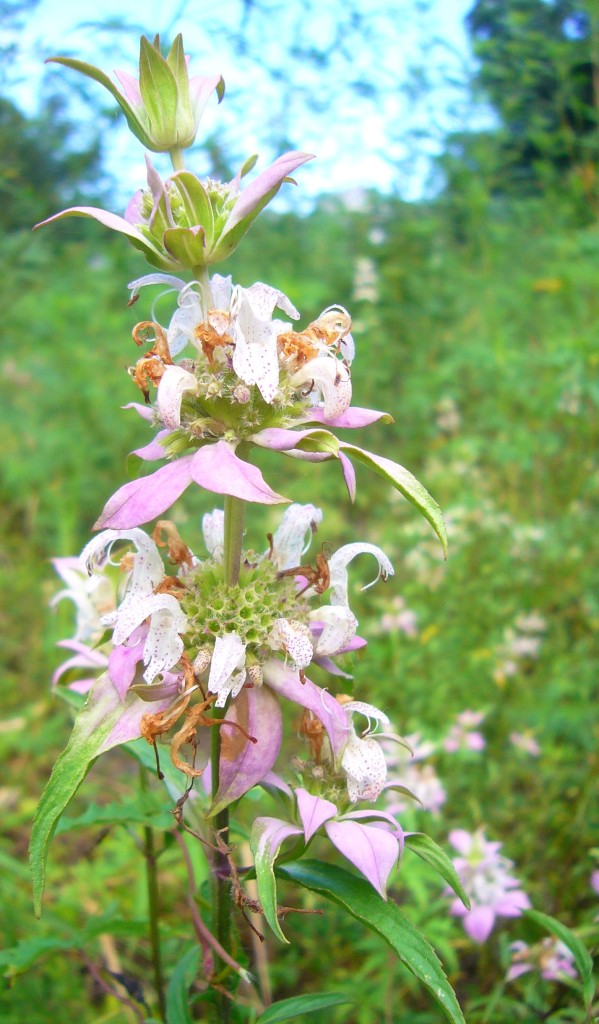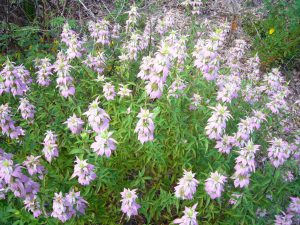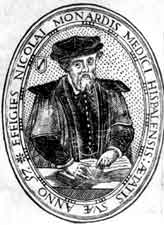Monarda Punctata: Bergamot’s Bud
First the good news: Horsemint makes a nice, intentionally weak tea. Stronger brews are used in herbal medicine. The Native Americans made a “sweating” tea from it to treat colds. The major oil in Horsemint is thymol. Externally it’s an antiseptic and vermifuge, internally, in large amounts, the plant can be fatal. That’s the bad news. So, as I said it makes a nice, intentionally weak, tea.
Horsemint is one of those plants that you seem to never notice until you learn to recognize it, then you see it every so often. It tends to grow in small colonies and near each other. If you find one, you will usually find another not too far away. They can vary in size from six inches to three feet but always very showy and its extroverted colors can last for months. You can propagate it by seeds or cuttings. I dug mine up and carried it home where it has a very sunny, well-watered spot in sandy soil.
The creamy lilac-spotted flowers (its bracts are pink) attract honeybees, bumblebees, miner bees, plasterer bees, swallowtail butterfly as well as the endangered Lycaenides melissa samuelis (Karner Blue.) Hummingbirds like it as well. Most mammals know enough to leave the plant alone. Horsemint grows from eastern Northern Canada down to Florida, west to Michigan and New Mexico and California, also into eastern Mexico. A southern variety, Monarda punctata var. punctarta, grows south of Pennsylvania and out to Texas. There are about 20 different Monardas in the United States.
Horsemint has the highest thymol content of all the mints. It is more than an antiseptic, mite-killer and cough-syrup ingredient. As a depressant, it is one of the most commonly abused substances among anesthesiologists and nurses. If thymol were discovered today it would be a prescription drug. There have been some thoughts towards regulating the species but it is so common in so many places that hasn’t been done. Thymol, incidentally, is also one of the 600 or so ingredients added to cigarettes to “improve” the flavor.
While thymol has a dark side it also has beneficial aspects. It is one of two chemicals in the horsemint — the other being carvacrol — which prevent the breakdown of acetylcholine, the stuff that makes memory possible. One of the symptoms of Alzheimer’s Disease is reduction in acetylcholine. Unlike a drug now used to prevent the break down of acetuylcholine — tacrine hydrochloride — thymol and carvacrol are not as rough on the liver. One could even make a shampoo out of horsemint and perhaps get the benefits.
As for the plant’s botanical name: Monarda is for Nicholas Monardes (1493-1588), a Spanish physician and botanist who mentioned this flower in his 1569 work on the flora of North America called “Joyfull Newes Out Of The Newe Founde Worlde”. Punctata is Latin for point, or in this case “dotted” because the flower petals have pink dots. The plant’s name is said: moe-NAR-duh punk-TAY-tuh.
Whether as a weak tea, a stronger brew for the flu, or a poultice for arthritis, the Horsemint, or Spotted Beebalm, is a pretty plant to spot while foraging.
Green Deane’s “Itemized” Plant Profile
IDENTIFICATION: Herb, sometimes woody, shrubby, gangly, multi-branched, opposite leaves and square stems. The stems and leaves are hairy. Flowers small, inconspicuous, but arranged in showy heads of pink to lavender bracts. Flower tubes are pale yellow with purple spots, less than an inch long, leaves smells like Greek oregano.
TIME OF YEAR: Can be year round in Florida but favors late summer and fall, in northern climates flowers June to October depending where you are.
ENVIRONMENT: Likes moist but well drained soil and sunny conditions, but can survive on rainwater in old fields and on roadsides.
METHOD OF PREPARATION: Leaves and flowers for weak tea, some report the leaves can use chopped up and use to flavor salads. Hanging leaves in the house leaves a nice scent.





Would you use Monarda citrodora in the same way?
Yes.
Is there a horse mint that is a perennial in eastern PA
I think I read somewhere that it is propofol (2,6-diisopropylphenol), not thymol, that is abused by some anesthesiologists and nurses. Thymol is similar but not as powerful.
If it works as a poultice for arthritis, do you think it could work on gout?
Great article, thanks!
I just made some tea with some to help with cold and allergy for my family my little girl loves it with a little sugar added
I recently transplanted some of this from an abandoned county lot. I didn’t notice the flower at the time, just the aroma. I figured it must be a mint, but was waiting to find out what kind. Thanks for the mention of horsemint in your newsletter. The flowers of mine are yellow, but I have not noticed any purple. Maybe it was just a weak purple. I will try to take a pic when I am able. I will try a weak tea next time I have a cold(as soon I am sure of its identity). Thanks.
One of my favorite flowers. Most around my part of Texas are white and bloom late spring. I love the darker purple ones but rarely see them and have wondered if the soil pH has anything to do with the bloom color. Have you ever made the tea? If so, what does it taste like? Seems like everyone in our family ends up with Alzheimer’s.
Thanks again for the great info green Dean. Still looking for Japanese Knotweed for Lyme medicine. Please let me know if you run across any.
Hugs from Spring Hill.
I know the post I’m replying to is several years old, but I didn’t want anyone to see it and think it would be good to plant Japanese knotweed to harvest for medicinal purposes. The Mid-Atlantic is overrun with Japanese knotweed! It is a TERRIBLE invasive exotic that chokes out native vegetation, especially on river and stream banks. It grows in very dense, tall clumps and spreads rapidly. There’s no practical way to eliminate it once established. I beg you not to plant Japanese knotweed, wherever you live!!!
Melalueca, a company that makes natural cleaning products, makes a Non-Toxic disinfecting cleaner with thymol called Sol U Gard ( Brand name)
I have used it for many years, it is registered for use in schools etc.
I was wondering where I can start my search for a course or class on foraging and what not? (Which is poison, which is edible, which heals)? Thanks
Love & Light
On my homepage under the button foraging there is a drop down menue. It says foraging instructors.Then click down to your state. There are some in Arizona and nearby states. They probably also know more about local classes as well.
Does anyone know where to buy this horsemint in the US? are there any US suppliers?
I bought seeds from http://www.floridawildflowers.com. They were slow-growing at first, but once the weather warmed, they grew quickly.
I just bought a plant at Taylor Gardens Nursery in Citra, FL. Off Rt 329 just near Sparr Lumber. Look up and give phone call for directions. Nice couple with many unusual items and good stock. Master Gardeners from Marion County buy there.
Do you have a favorite plant book for identifying these wild plants? In episode 17
I thought you had a book you put pressed samples in on their description page.
Yes, where do yo live?
I live in central Florida, The Villages. What plant identification book do you recommend? I’m new to this site.
Florida’s Wild Flowers and roadside plants was my first and has stood the test of time.
flowers and road… on Google
Florida Wild Flowers and Roadside Plants by C. Ritchie Bell – Used (Very Good, ex-library) – 0960868836
Florida Wild Flowers and Roadside Plants by C. Ritchie Bell – Used (Very Good, ex-library) – 0960868836
$3.99
Thriftbooks.com
Florida Wild Flowers and Roadside Plants; Paperback; Author – C. Ritchie Bell
Florida Wild Flowers and Roadside Plants; Paperback; Author – C. Ritchie Bell
$3.00
Barnes & Noble
Florida Wild Flowers and Roadside Plants
Florida Wild Flowers and Roadside Plants
$23.08
AbeBooks
Free shipping
Identifying & Harvesting Edible and Medicinal Plants (ebook)
Identifying & Harvesting Edible and Medicinal Plants (ebook)
$12.99
Google Play
Free shipping
Florida Wild Flowers And Roadside Plants Hardcover 2007
Florida Wild Flowers And Roadside Plants Hardcover 2007
$10.00
eBay
Roadside Guide To Michigan Plants, Trees, And Flowers: An Ecological Approach
Roadside Guide To Michigan Plants, Trees, And Flowers: An Ecological Approach
$31.82
Discover Books…
Special offerSpecial offer
Roadside Plants and Flowers; A Traveler’s Guide to the Midwest and Great Lakes Area; Paperback; Author – Marian S. Edsall
Roadside Plants and Flowers; A Traveler’s Guide to the Midwest and Great Lakes Area; Paperback; Author – Marian S. Edsall
$1.99
Barnes & Noble
Florida Wild Flowers and Roadside Plants
Florida Wild Flowers and Roadside Plants
$15.43
OlivesBooks
Free shipping
View all
Search Results
Florida Wild Flowers and Roadside Plants: C. Ritchie Bell, Bryan J …
https://www.amazon.com/Florida-Wild-Flowers-Roadside-Plants/dp/0960868836
Florida Wild Flowers and Roadside Plants is a helpful guide to identifying 500 species of Florida plant life, including rare as well as common wild flowers and …
Thanks Green Deane. I appreciate your extensive knowledge that you bring to the fore. If you ever got a guided hike together, I’d be the first on board.
Guided hike… that’s kind of what my classes are…
Just noticed a large spotted horsemint growing on my weed-covered slope outside my home here in Levy County. It is a beautiful plant. Thanks for the info…the good and bad news. Very informative.
I had read that this is one of the plants that truly deters mosquitoes. Can you verify if this is true? If it is, I would like to get some plants, not seeds.
Thanks
Ellyn
I have not heard that. I do know that it does attract a lot of insects.
I am new to this site & love reading about natural remedies using herbs. Last year I threw out some wild flower & bluebonnet seeds at my home in south Texas. Got some wondderful color for my efforts. Had wondered about these beautiful & litely aromatic flowers, horse mint. This spring they came up in my wildflower garden in abundance! I was thrilled!! There are also a lot of indian blanket flowers mixed in with them. This year I am going to dry them & try some infusions. Thanks for all your info!!
Just found horsemint in my Wildflowers of Texas book, and an online search brought me to this site. Have it growing right next to my garden, a large swath of them. They are pretty and very intricate looking. Thank you for the in-depth information!
I’m just wondering where you find information about this plant’s toxicity? There seems to be none available online and no sources for this article.
I did and do most of my research from books in universities.
Many years ago I had the flu so bad I was sick abed and had to catch a morning plane next day. My mother gave me a cup of hot tea to drink and I woke up three hours Later wet with sweat, wet bed sheets, barely conscious. She bathed me, put on clean pj’s clean sheets, towel under me, and made me drink another cup of hot tea. I woke up In three hours drenched with sweat and she did the same thing again. I awoke at six a.m. dry, well, and able to make my flight! I have gathered this wild plant and used it to cure colds and flu ever since!
We have horsemint in abundance (Northeast Texas). I was thinking of making a tincture with it. How would I use it?
Hi, I have not seen in my other readings that Horesemint/Beebalm can be fatal! I am actually including this herb in my Materia Medica. Can you list your source for the safety info (fatalities) so I can review further. Thanks so much!
Just curious, is horsemint safe to burn? I was going to add it to an herbal bundle with sage.
My honey bees get into the horsemint.
It gives their honey a slight minty after taste